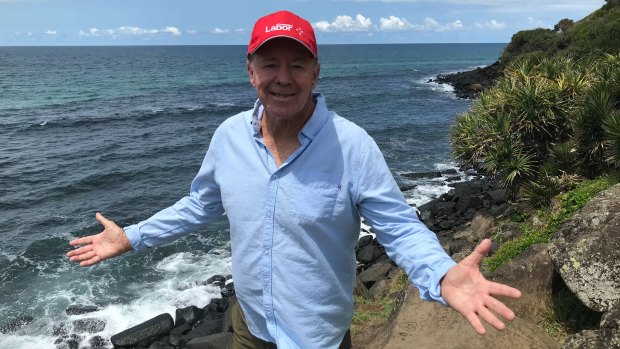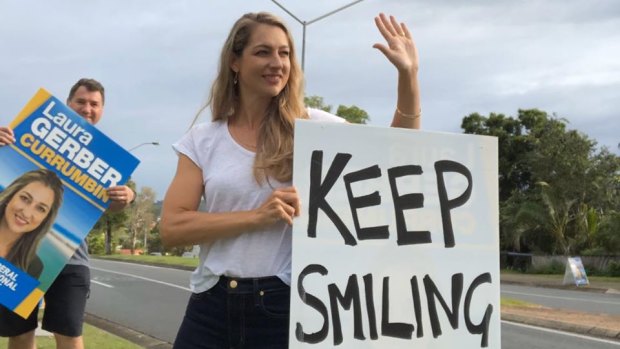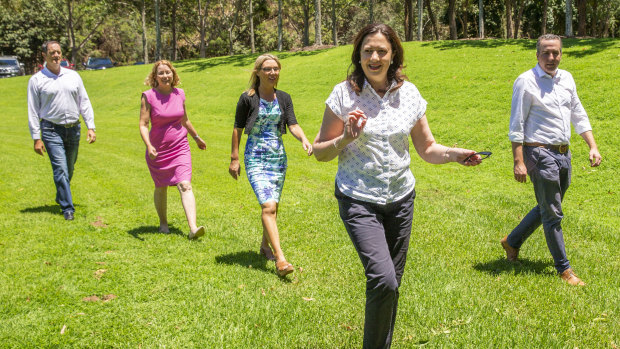This was published 4 years ago
Changing demographics behind Labor's increasing coastal vote: Expert
By Tony Moore
Changing demographics played a big part in Labor's increased vote on the Gold and Sunshine coasts, a University of Queensland political expert said as votes continued to be counted in tight coastal races.
Labor picked up two Sunshine Coast seats, Caloundra and Pumicestone, in both instances replacing popular retiring LNP MPs.

Labor's Burleigh candidate Wayne “Rabbit” Bartholomew is still in contention to win the seat of Burleigh.Credit: Tony Moore
On the Gold Coast, the LNP is fighting hard to hold the two seats closest to the NSW border.
UQ political historian Chris Salisbury pointed to "shifting demographics" on the northern end of the Gold Coast, along with the southern side of the Sunshine Coast, making traditionally blue-ribbon seats more feasible for Labor.
"Labor might actually be disappointed with how they come out of the [Gold Coast]," Dr Salisbury said.
"This was really where they were putting a lot of effort in, in an effort seemingly to offset what were expected losses in the north.
"In terms of further south on the coast, I really do think that they were ripe for picking because of the pandemic and all of the issues at play there.
"I don’t know that necessarily they’ll remain as competitive."

The LNP's Laura Gerber is battling to hold Currumbin on the Gold Coast.Credit: Facebook
By the end of counting on Monday, only about 512 votes separated the LNP’s Currumbin incumbent Laura Gerber from Labor challenger Kaylee Campradt, with about 70 per cent of votes counted.
In Burleigh, Wayne "Rabbit" Bartholomew, Premier Annastacia Palaszczuk’s captain's pick as Labor candidate, was about 943 votes behind three-term LNP veteran Michael Hart.
In Coomera, the LNP’s Michael Crandon is fighting a tough battle to fend off Labor's Chris Johnson.
The Electoral Commission of Queensland rates these three Gold Coast seats as too close to call.
Elsewhere on the Gold and Sunshine coasts, the LNP has secured comfortable wins.
In the northern edge of the Gold Coast, Sam O’Connor has easily won Bonney, David Crisafulli has won Broadwater, Ros Bates has reclaimed Mudgeeraba, Rob Molhoek has won Southport and former leader John-Paul Langbroek has comfortably won Surfers Paradise.
Labor’s Meaghan Scanlon has held Gaven, in the Southport hinterland.
Aside from the Labor gains on the Sunshine Coast, the LNP has held Glasshouse (Andrew Powell), Gympie (Tony Perrett), Kawana (Jarrod Bleijie) and Maroochydore (Fiona Simpson).
As of counting on Monday, Labor had increased its statewide vote by 4.7 per cent. The LNP increased its vote share by 2.1 per cent, mostly at the expense of One Nation.
One Nation’s vote dropped by 6.7 per cent and the Greens' statewide vote dropped 1 per cent.
In Caloundra, former Woodford Prison officer and retired army officer Jason Hunt claimed the seat for Labor from retiring LNP frontbencher Mark McArdle.

Victory lap: The Premier with new Labor MPs Jason Hunt (Caloundra), Ali King (Pumicestone), Jonty Bush (Cooper) and Jimmy Sullivan (Stafford).Credit: Glenn Hunt
"This was my third run, so this has been the culmination of a six-year journey," he said.
"There was a lot of pressure on myself and my team, but I didn’t want to think about it.
"A senior [Labor] party member just told very early on: 'Just take one day at a time, that is all you can do'."
Mr Hunt believes he has the ear of Ms Palaszczuk as the Sunshine Coast tries to claim some of the media focus given to the Gold Coast.
"One of our most pivotal commitments prior to the election was the Bells Creek Arterial Road, which connects Caloundra South to the Bruce Highway," he said.
"That’s started and was locked in before the election and the campaign, so she is already in that zone."
Mr Hunt said he was yet to discuss the Sunshine Coast’s rail infrastructure "in any great depth".
"As you can imagine, the next few weeks are going to be a pretty steep learning curve," he said.
Mr Hunt moved from Sydney to the Sunshine Coast in 1973, went to Currimundi State School and Caloundra High School, before joining the military.
He served in Brisbane, went to university where he studied education and history before joining Corrective Services. He was a custodial officer at Woodford Prison for 21 years.